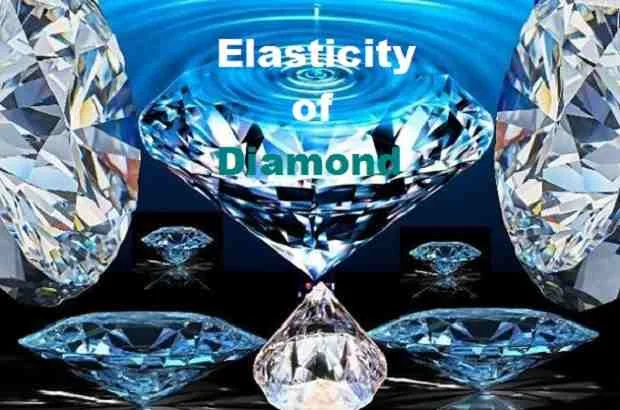Diamond is a crystallized form of carbon with a cubic crystal structure. Diamonds are the strongest substance found naturally on Earth.
Researchers
have revealed that brittle diamonds can be bent and pulled very fast when made
into ultrafine needles. At room temperature and pressure, diamond is metastatic and graphite is
stable, but the diamond almost never changes into graphite.
 |
| A novel method to grow elastic diamonds |
A
Novel Method to Grow Elastic Diamonds -Ultra-large Elastic Deformation of
Nanoscale
Elasticity of Diamond
Diamond is a crystallized form of carbon with a
cubic crystal structure (a square or rhombus-shaped figure that is usually
oriented with long diagonal vertical).
At room temperature and pressure, it is
metastatic and graphite is stable, but the diamond almost never changes into
graphite. It is usually almost colorless when it is highly valued in the form
of a precious stone free of transparency and error.
This is the most naturally occurring material on
earth. It is famous for its excellent physical properties, most of which arise
from the strong covalent bond between its atoms. In particular, it has high
hardness, extraordinary thermal conductivity, high chemical resistance, and
high optical transparency of any bulk material.
These notable properties of the diamond
determine many technical and industrial applications, for example, cutting and
polishing tools and scientific applications in diamond knives and diamond
allele cells.
Ultra-large elastic deformation of nanoscale diamond
In the last research, the Institute
of Basic Sciences (IBS) and the Center for Multi-Dimensional Carbon
Materials (CMCM) at Ulsan National Institute of Science and Technology
(UNIST), in collaboration with Hong Kong City University, and Nanyang Technical
University jointly organized a study about the nature of the diamond and
published their report in the journal "Science" this week.
The team has unveiled that brittle diamonds can
be rotated and spread on a large scale when ultrafine needles are made.
The team showed that their nanoscale diamond
needle can flex and stretch up to nine percent without breaking, then return to
its original size. Their discovery completely reverses the full principles that
diamonds are brittle.
Their results can open up unprecedented
possibilities to tune their optical, optometric, magnetic, photonic, and
catalytic properties through elastic tension engineering.
 |
A novel method to grow elastic diamonds
|
UNIST introduces a novel method to grow elastic diamonds
According to the researchers, a
percentage of a simple diamond in bulk form is below the stretch and diamond
needles are flexed up to 9% without any breakage.
In the study, Professors of Ming’s group handled the analysis of chemical computation and diamond crystal structure and said that the ultrahigh elasticity of diamond nano nodes is due to internal defects and lack of relatively smooth surface.
Diamonds, either natural or synthetic, have internal defects in
their crystal structures when external forces are applied to these defects,
they can crack and eventually break. The ultrasonic elasticity of diamonds is
due to a lack of internal defects.
The researchers determined how much stress and strain can be without breaking the diamond needles. They determined that the respective maximum local tension was close to the known theoretical boundary with a perfect, faultless diamond. They noted that without defective diamonds, 12% can spread without breaking.
And
large elastic deformation in needles of nanoscale diamonds will be suitable for
use in the next generation's flexible and foldable display.
Researchers
had hoped that their findings could lead to an increase in performance of
applications including bio-imaging and bio-sensing, stress-intermediate
nanomechanical resonators, drug delivery, data storage, and optometric devices
as well as an ultra-strength nanostructure.
In
addition, Professor Ding noted that large elastic deformation in needles of
nanoscale diamonds would be suitable for use in the next generation's flexible
and foldable displays.
Researchers at the City University of Hong Kong succeeded in creating nanoscale diamond needles with a plasma-induced etching of diamond thin films deposited on C substrates through bias-supported chemical vapor deposition.
The team measured the inclination of diamond needles, which were
grown through the process of a chemical vapor depositing and then with a
standard nano pendant diamond tip, while pressing the needles, looking at them
in the scanning electron microscope, was carved.
And they experimentally demonstrated that single-crystalline
needles are highly susceptible to ultra-strong and large elastic deformation,
in which there is a completely inverse mechanical disorder, up to 9% elastic
tensile strain and stress.
Tags
diamond
diamond properties
diamond rings
latest technology trends
modulus of elasticity
science
technology
